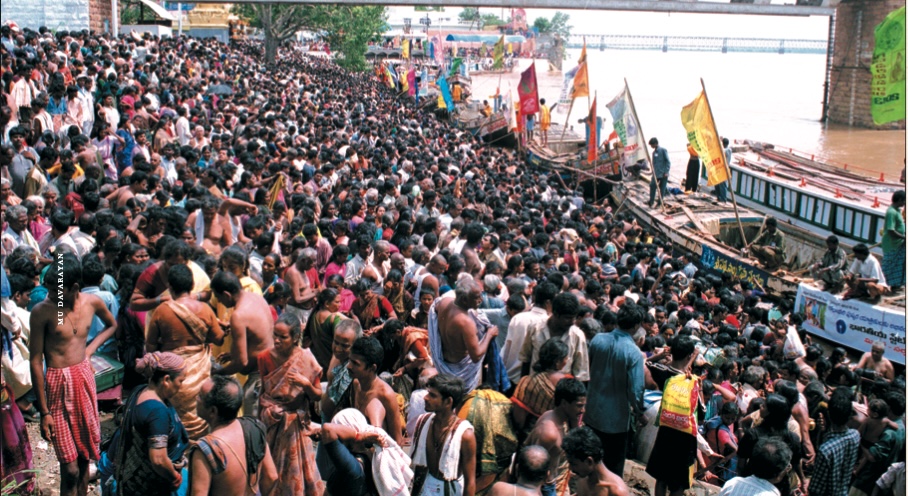BY MANGALA PRASAD MOHANTY
It is one moment past midnight on Monday, July 28, 2003–the first day of South India’s famous Godavari Pushkaram festival. Already thousands of devotees from all over India have flooded nine temple towns in Andhra Pradesh dedicated to the celebration of this twelve-day religious extravaganza honoring Lord Siva.
I am here in the town of Rajmundhry, the nerve center of this grand, state-wide event. Although I have attended many large religious festivals like this, I continue to be amazed at how each one seems to maintain its own sense of awe. There is a raw potency in this slowly flowing mass of people–like the quiet dynamism of an elephant that usually remains subdued, yet could erupt with uncontrollable force at any moment. Such is India, its peace and its power, side by side.
Every single pilgrim here is determined to do one thing: Take a holy dip in the Godavari River. Some bathe right away, as soon as they are able to penetrate the thick crowds and reach the water. Many wait for the most astrologically auspicious moment, which is 12:59 pm on Wednesday, July 30. Still others linger longer, patiently taking their turn in the natural timing of the colossal event. By the end of the first day, over a half million pilgrims have taken their coveted holy dip. By the festival’s end on August 10, that figure will rise to an estimated forty million–more than twice the number of those who participated in the same festival when it last occurred, in 1991.
The state government of Andhra Pradesh spent us$38 million in preparation for the event, and the Central Government contributed more than eleven million. These preparations included elaborate arrangements to establish lodging, dressing facilities, public toilets, drinking water, cloak rooms and shoe stands. Two hundred TV control centers were erected to monitor crowds, and thirty thousand police were dispatched to maintain order. While thorough efforts have obviously been made to anticipate every conceivable emergency, the atmosphere is still permeated with an uncertain feeling of impending chaos as the drama actually begins to unfold. In the end, however, all will turn out well–primarily because of careful planning and precautions.
Godavari, a Burmese word for “river, ” is also a name for Siva in the form of flowing water, like “Ganga ” or the “Ganges.” A pushkaram is a distinguished event. Hence, the Godavari Pushkaram is an auspicious occasion dedicated to the worship of Siva with prayers for the descent of divine grace for the improvement of life.
It is believed that benefits derived from religious disciplines practiced during Godavari Pushkaram are compounded exponentially. Such disciplines include the performance of charity, japa (the recitation of mantras), worship, meditation and ritual bathing. Ritual bathing is especially popular, since it is believed that during this festival time the river itself takes on great mystical powers capable of revitalizing life, curing physical ailments and bestowing spiritual unfoldment. Often referred to as South India’s Maha Kumbha Mela, Godavari Pushkaram occurs only once in twelve years.
According to ancient legend, a great sage and devotee of Lord Siva named Gouthama performed such rigorous penance in South India that he actually succeeded in bringing divine grace down to Earth in the physical form of flowing water, right from the tresses of Siva’s henna-red hair. The place this sacred water is said to have fallen is called Triambaka, located in the Nasik district of Maharasthra. Triambaka is the origin of the river Godavari, which flows from there across India into Andhra Pradesh.
The nine temple towns hosting the festival in the state of Andhra Pradesh this year are Basara in Adilabad; Dharmapuri and Kaleswaram in Karimnagar; Bhadrachalam in Khammam; Kovvuru in West Godavari, Rajmundhry and Pattiseema; and Draksharamam and Antharvedi in the East Godavari Districts.
To enrich the festival, the State Tourism Department organized cultural exhibitions and ethnic food festivals in these towns. Also featured were literary and cultural programs, including religious discourses, devotional music, poetry readings and stage plays. All through the twelve days, priests were furiously busy everywhere, performing family religious rites along the river. In particular, the rituals honoring death anniversaries are a primary custom performed during Godavari Pushkaram.
In Rajmundhry, just before the festival began, a giant Siva Lingam was installed near the main river ghat to creatively assist the pilgrims in taking their holy bath (see photos). This massive Lingam is bathed with water from the Godavari, which overflows its base to shower nearby pilgrims gathered to receive the blessings of the sacred water. I was one of those devotees. I was blessed. I am blessed.
